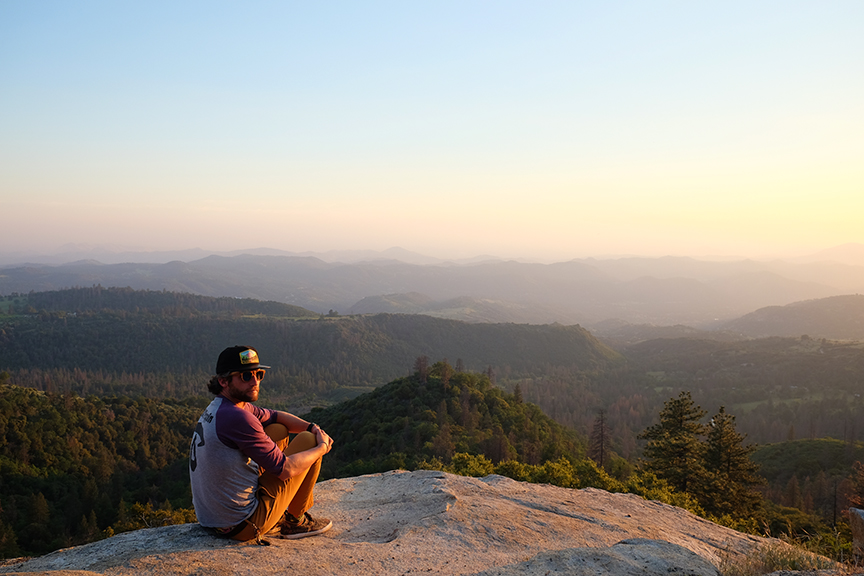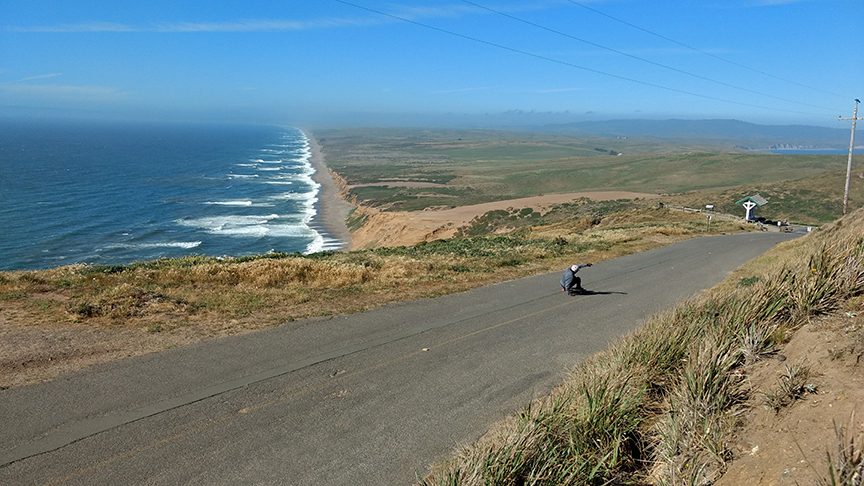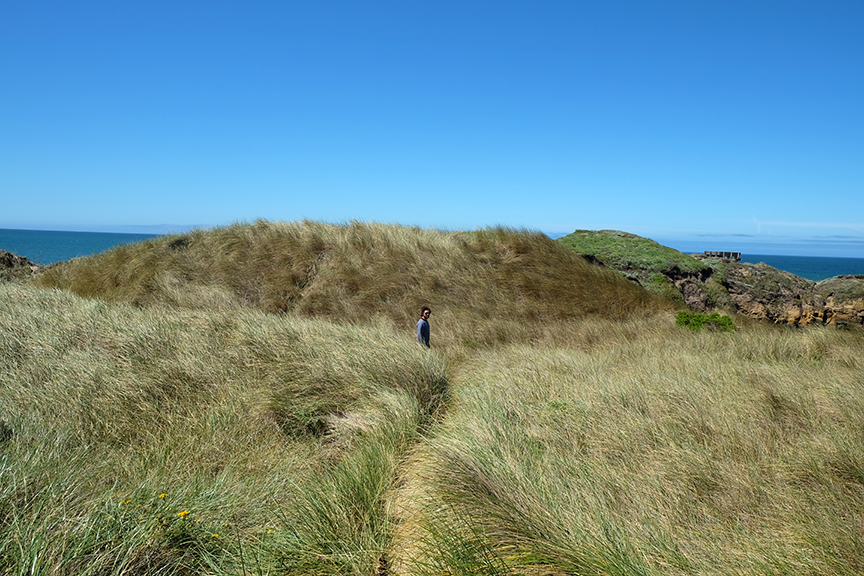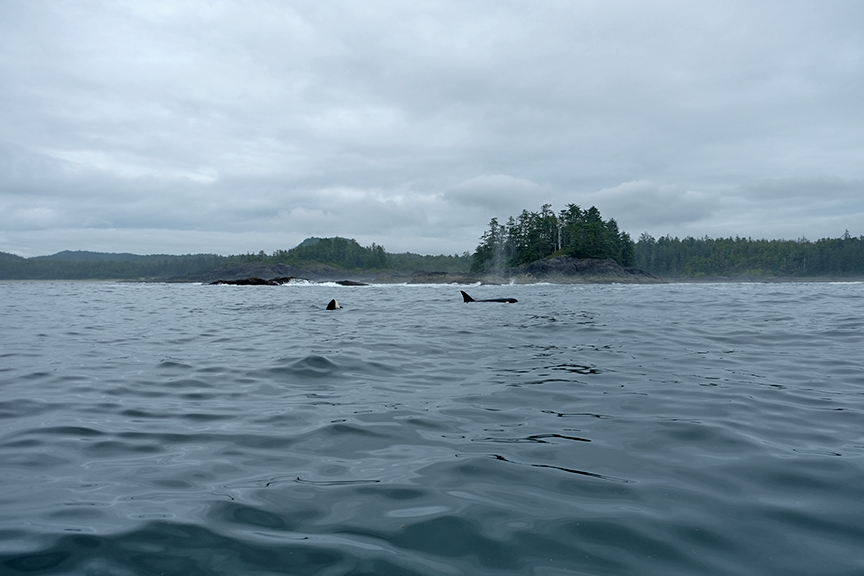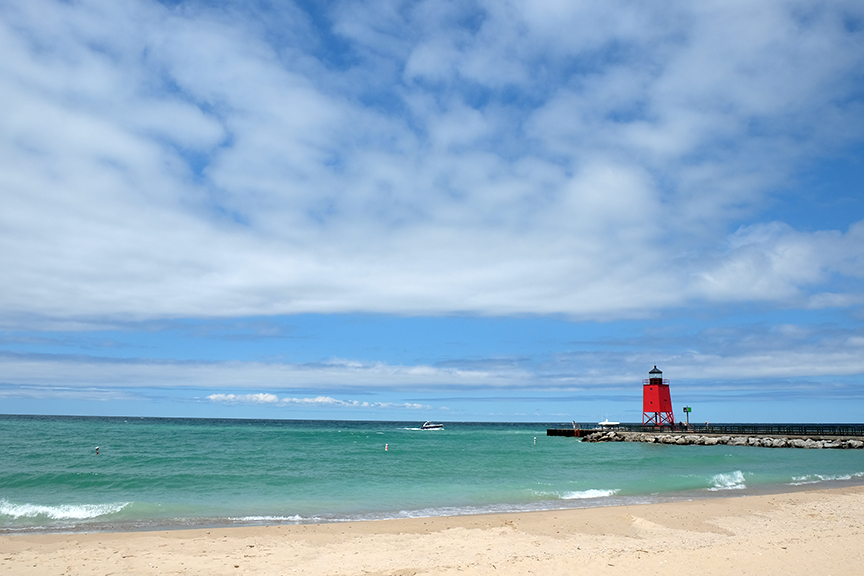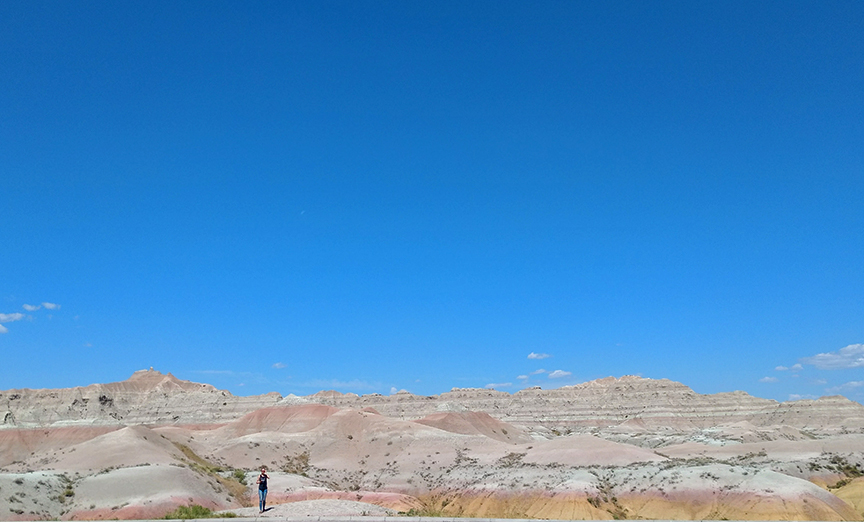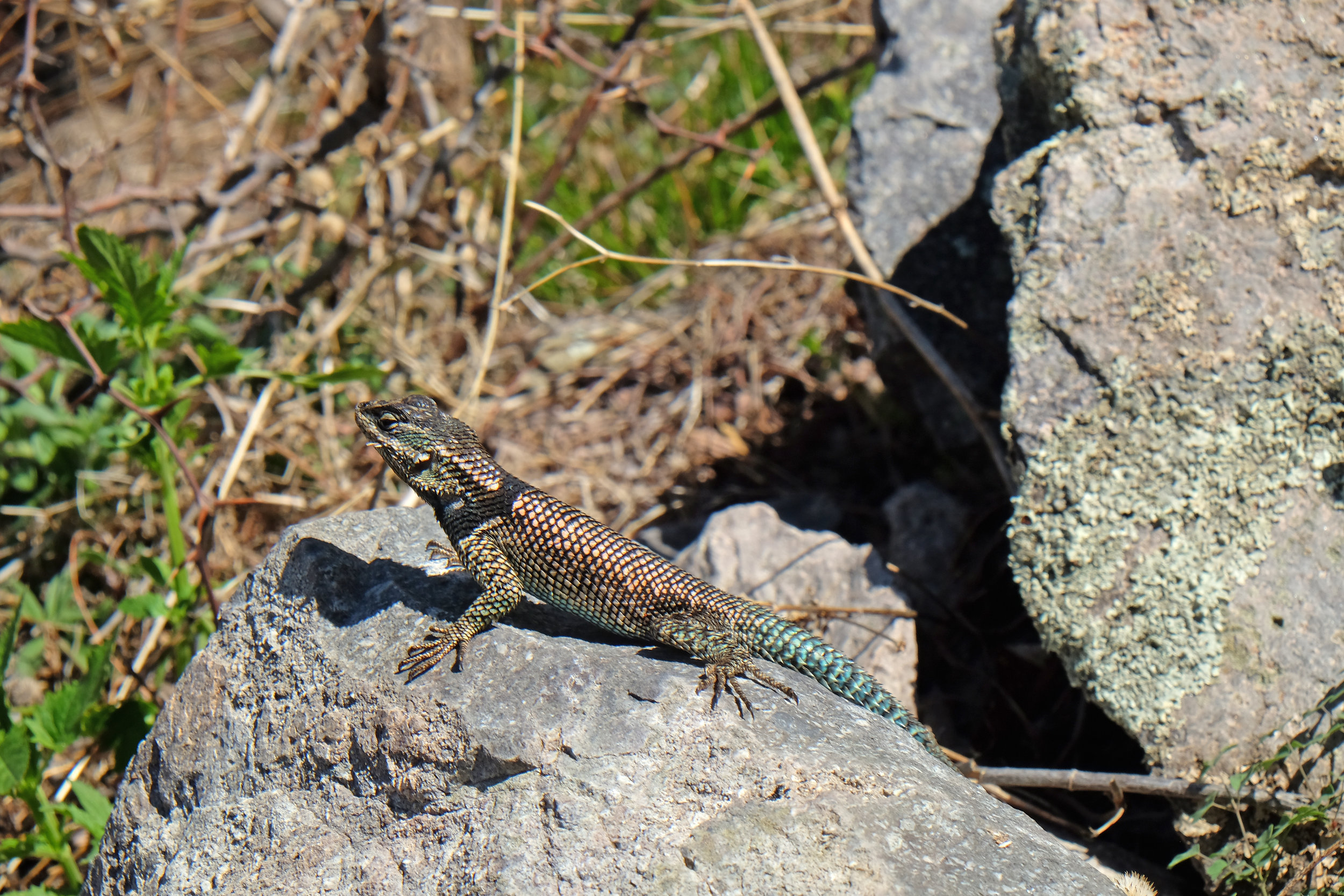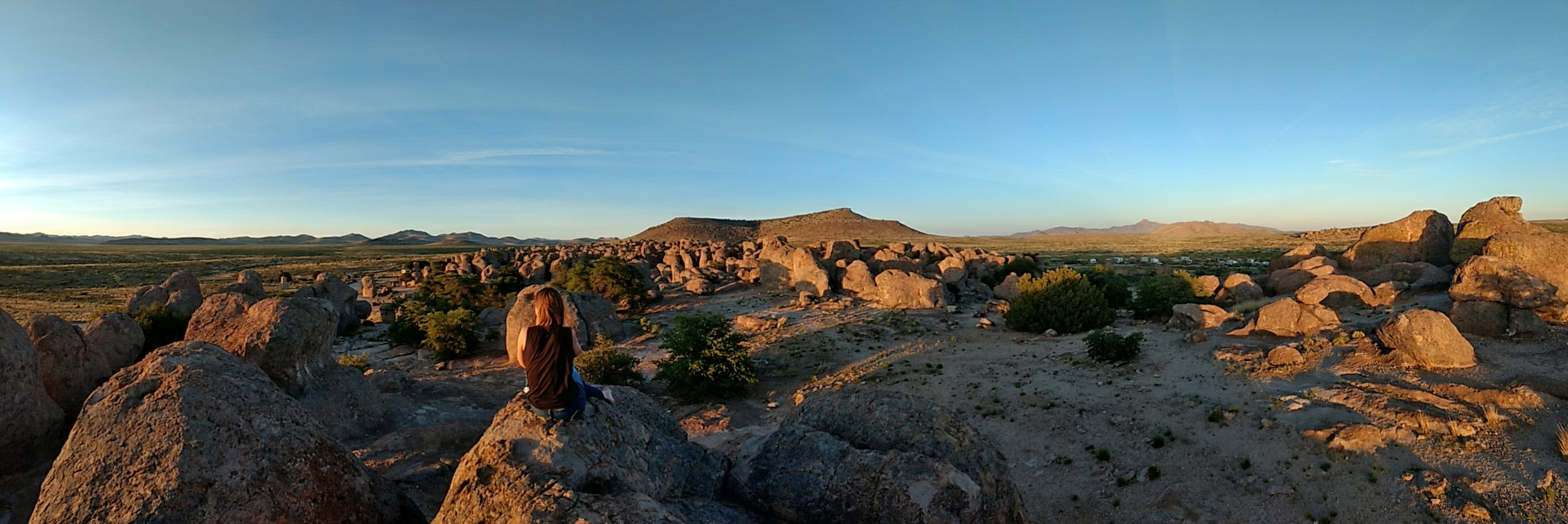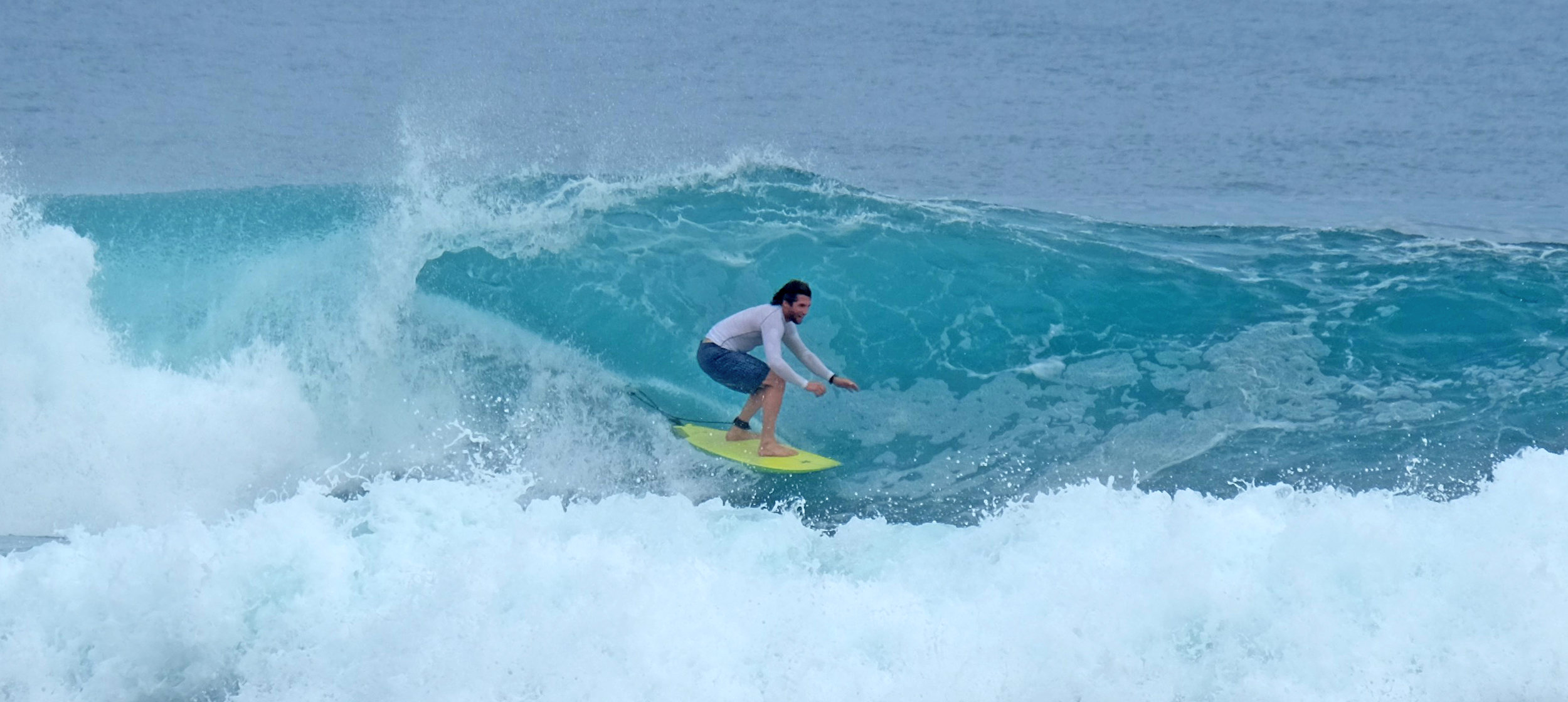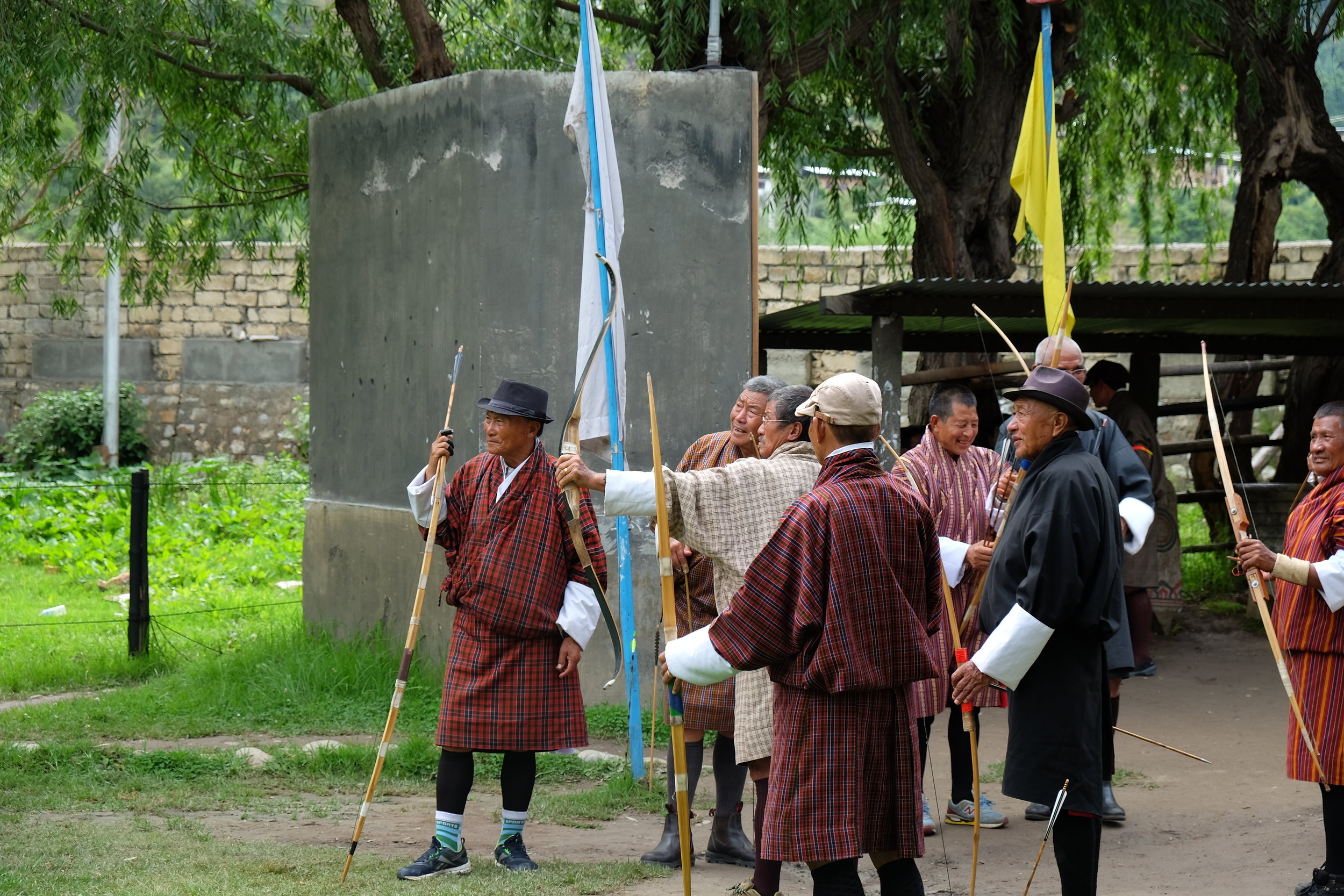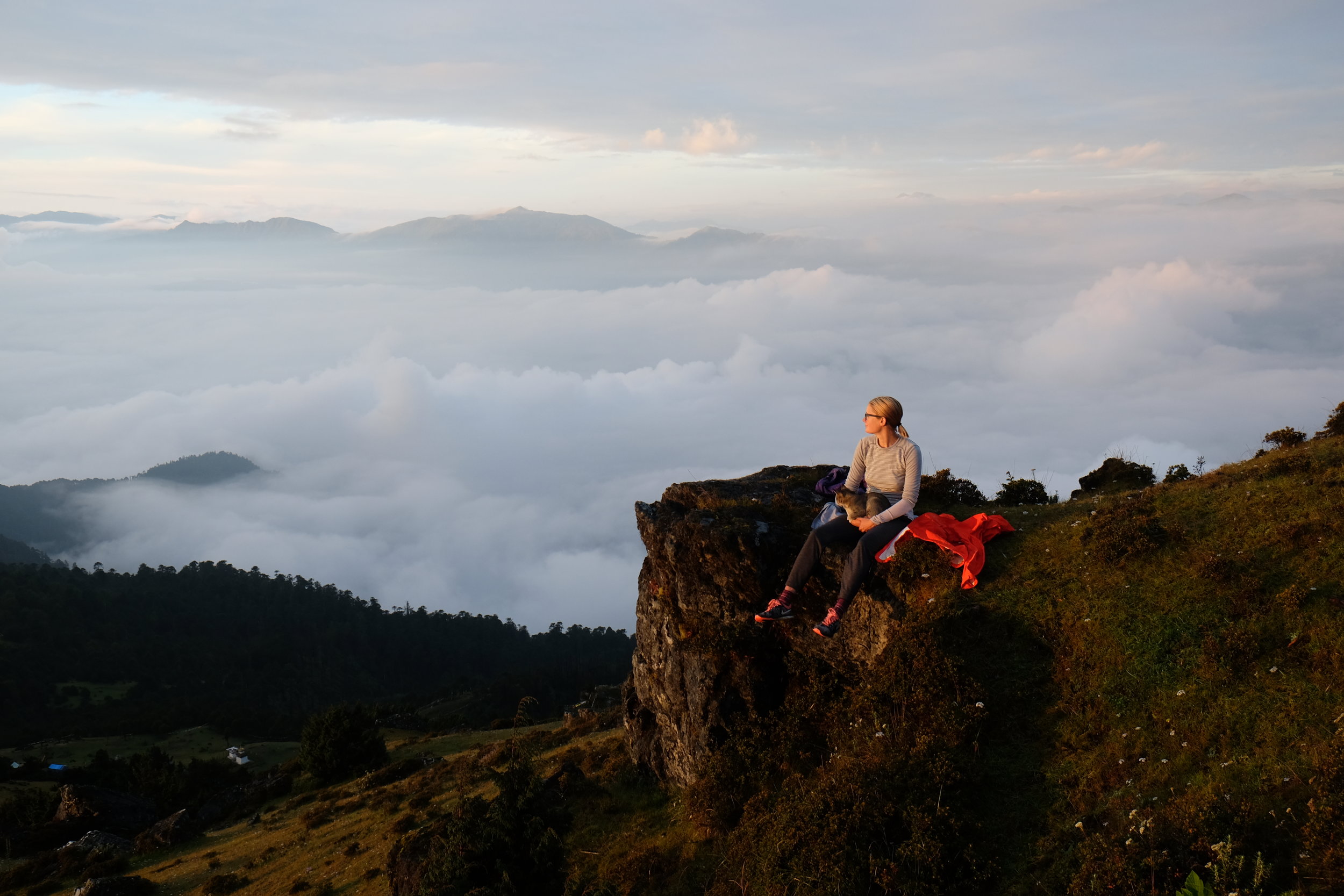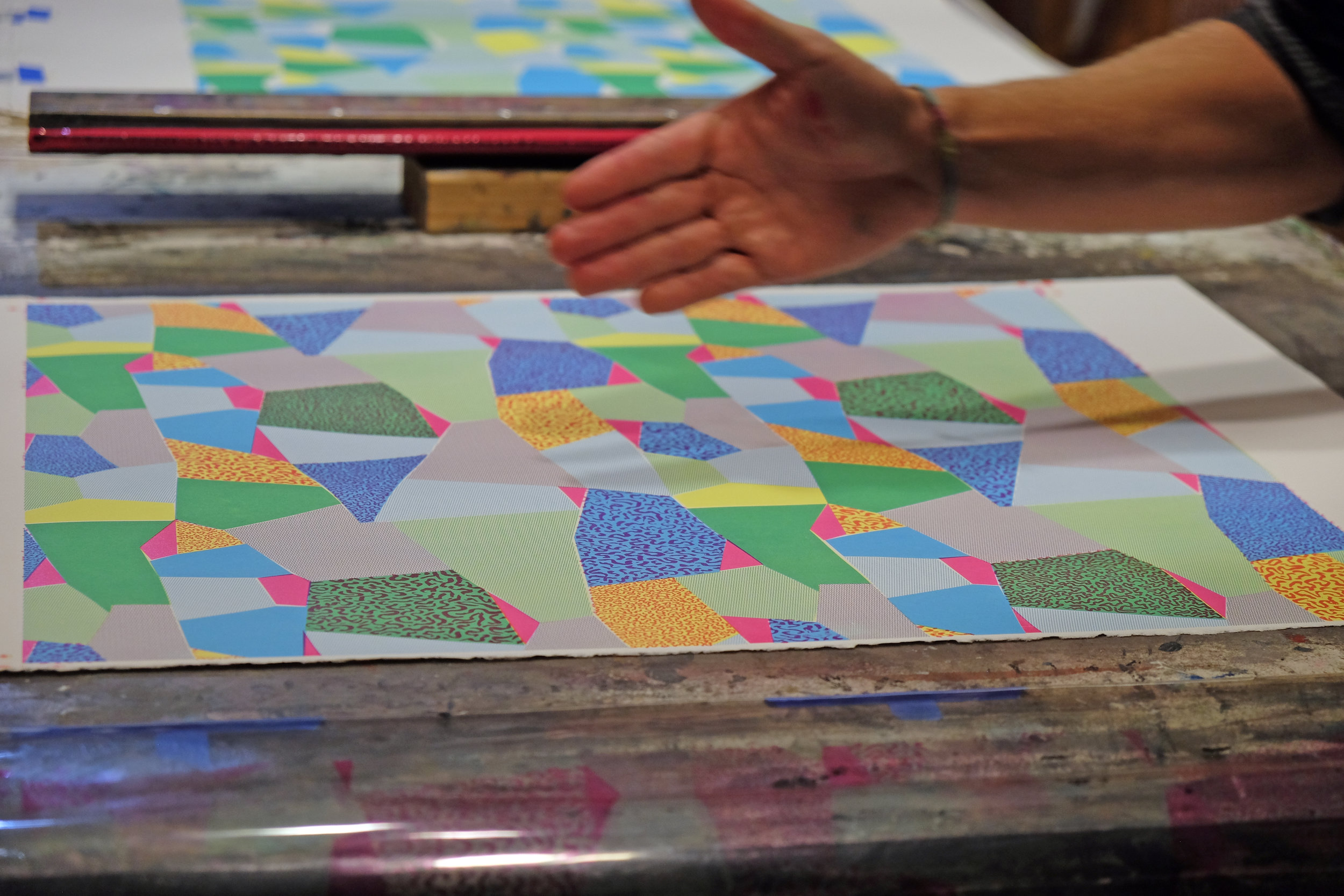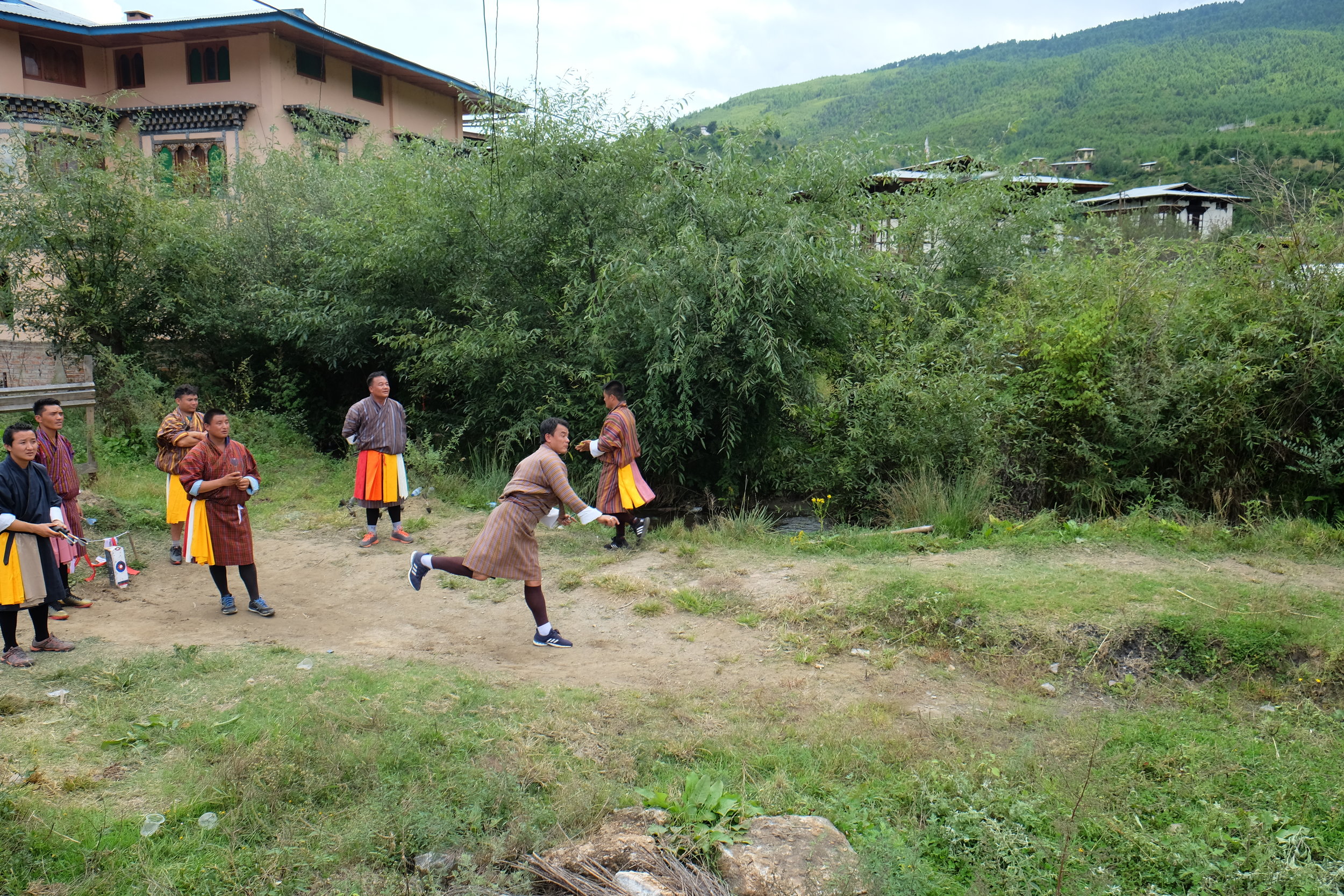Posted by Kaspar (currently in Udaipur, India) covering September 23rd - September 29th in Bhutan
Bhutan brings to mind a Buddhist paradise, a Shangri La and rumors of having found the secret to happiness in the modern age by measuring success with Gross National Happiness instead of "Product". It holds a romantic place in our minds (as westerners who have mostly heard rumors). The reason for this romanticism is a very closed border with exorbitant prices for tourists (other than Indians and Bangladeshis) to enter and a tight control on the way the country is presented. It would be cynical to assume that this perfect image is not real, when you see the pictures below you will understand that the beauty is indeed real, however, what we began to discuss in Bhutan is the nature of happiness and beauty. Can there be only one definition? Does it not take some pain and hardship to then experience happiness? For anyone who has watched the Matrix recently (as we have) you will remember that humans rejected the first version of the Matrix exactly because it was meant to be a perfect utopia where there was never any pain, only happiness. Has Bhutan perfected happiness? Is that even possible?
We went to Bhutan with open hearts and were rewarded with infinite beauty, but it is hard not to feel that there are things lurking under a surface that is so highly polished. It leads you to believe that maybe there are parts we are not meant to see or maybe something that is being hidden...
The closest thing to flying into Paro that I have experienced is flying into Kathmandu, but this is more extreme in a narrower valley with a smaller target. You can see in the picture above how close you are to the mountains when you land. What you can't hear are the monks in the next row chanting mantras that you assume translate to, "please lord Buddha, don't let me die today" as the plane lurches and staggers over the mountains while Ali begins to wonder out loud what I have started questioning myself, is this outside the norm for turbulence on this flight? The reward is what to the Bhutanese is a bustling city and to us is an idyllic valley bathed in a holy glow and painted by sections of green rice fields. This glow is not a photoshop trick. The moisture in Bhutan hugs the mountains in little cotton candy wisps or cascades into the valley in sheets causing these magnificent lighting effects that seem other worldly.
View of Paro from the National Museum
Full disclosure: Going to Bhutan costs $250 a day, per person, PERIOD. This means that it is not completely overrun by tourists and every experience you have is carefully curated, but it also means that the vast majority of people do not get this opportunity. When Ali and I planned this adventure we stuck Bhutan in from the beginning and carved it out of the budget as a "must do" no question. We were greeted at the Airport by a driver Dorje and a guide Lobsang (see picture below). They loved this one Bhutanese pop star and played his hit single on repeat much of the time in the car. These guys were top notch, could answer any question, spoke perfect English, totally unflappable like parts of a well oiled tourism machine, which only made us want to look under the hood of this utopia even more. On the drive into Paro there are signs that warn against the dangers of drunk driving and there are some warning against the dangers of prescription opioids leading one to believe that Bhutan still has its own struggles just like the rest of the world.
Games
We were taken to the Hotel Gangetsy which is a converted antique mansion that overlooks Paro, we visited the Paro Dzong (fort). Dzongs are a defining feature of the Bhutanese political landscape because they house the government offices in a system that was established by Ngawang Namgyal in the 17th century (the Buddhist master and emperor credited with establishing much of Bhutan's present day identity and traditions). On the way to the Kyichu Lhakang Temple we passed a group of guys playing Khuru (darts). They were dressed in their Ghos, which is the Bhutanese national dress and is required for official functions or in this case to celebrate "Blessed Rainy Day" when all natural waters wash away ones sins and everyone comes out to play. These darts have steel tips and they throw them back and forth at each other's targets getting scary close to the opposing team. They like to shout chants at each other and when they score everyone does a little dance like an end zone celebration dance. We asked what exactly it is that they are saying to each other because we could imagine some harsh insults being hurled. Lobsang says, "oh they say things like 'baldy baldy you'll never hit the target" which to us is hilarious because it is not really that insulting, but in a place like Bhutan it passes for a harsh taunt.
Back in Paro we stopped off at the archery grounds where the old school guys were facing off in the national sport of archery. The targets are about 100meters apart and the way they shoot is not a slow and controlled technique as you might imagine archery to be. They pull back the string quickly and drive the bow forward at the same time more like they are flinging the arrow. It is a wild flailing motion and I could not see how it contributed to anyone's accuracy, but that is their style. Meanwhile members of the opposing team are standing by the target shouting their mildly offensive insults to psych out their opponents while simultaneously flinching if the income arrow misses the target and strikes close to them.
The Markets
The nice thing about shopping in Bhutan is that you can be pretty sure what you are buying is from Bhutan. Yes they have some of the same jewelry and metal ware that you might see in Nepal or India, but there is a specific pride in Bhutanese made products particularly when it comes to fabrics and many of the stores have a certification of origin. Ali got a Kira, which is a bolt of cloth that is wrapped in a particular robe-like style and belted. I tried on a Gho. The cool feature about these outfits is that the front breast of the robe acts as a huge pocket and you see people pulling all manner of items out of their clothes at any time during the day like a magic bottomless pocket. We asked Lobsang where he got his Gho from and he said that his wife made it. We expressed our appreciation at her sewing skills and he looked at us quizzically explaining that she actually wove the fabric. We confirmed with, "like she literally wove it from scratch?" Lobsang responded, "yes of course" with the look of 'duh' on his face.
The Temples
Why are people obsessed with going to Bhutan? The mountains, the nature and the happiness yes, but really its for the temples. The last temple we visited on our trip is the most visited site in Bhutan and it is easy to see why. We gradually worked our way up to seeing the Tigers Nest having criss-crossed the country seeing every little shrine and temple we could over the previous 5 days. Lobsang had planned it perfectly so that we had camped the night before above Tiger's Nest and could descend to the hanging cliff arriving fresh and energized. You can see why the Buddhist Master Guru Padmansambhava from Tibet would want to fly to Bhutan on a tiger's back in the 8th century to meditate here for 3 years, 3 months, 3 weeks, 3 dayas and 3 hrs. This inspired a string of Buddha's important disciples to come worship and establish temples here.
Tiger's Nest
Inside the temples no pictures are allowed, but generally you have a central figure, usually an incarnation of Buddha himself with Guru Rinpoche and Ngawang Namgyal (the great unifier of Bhutan). The walls are painted in detailed depictions of the life of Buddha, the shrines are covered in butter lamps and various offerings. There is almost always incense, usually juniper, and or butter lamps burning and an overwhelming sense of calmness. We would often just sit and meditate while Lobsang would prostrate himself and speak with the temple caretaker. Below are some pictures of details typical of the exterior of the temples like prayer wheels and paintings of the wheel of life. Below upper right was one of our favorite temples set into a cliff, called Bumdra Temple or "Temple of 100,000 imprints" for the marks on the rock that represent the 100,000 dakinis (angels) that left their indentations here.
The Food
We need to talk about the food for a minute. Part of the problem with tourism is an assumption about food. The assumption is that people travel to meet foreign people, to see foreign art, to hear foreign music, walk around in foreign architecture and buy foreign products, but when you ask them if they want to eat foreign food they say "ewwww." We would find this to be the case in many countries where even when you ask to try the local food they would say, "ok, but with out the spice, right?" or "No you don't want to try that." Its like foreigners are allowed access to everything accept the food. After one day of going to the "approved" restaurants for our bland meal we made it clear to Lobsang that we wanted to eat the real deal and he hooked it up.
If you like pork, you will love sikam paa, which is fatty cured pork fried with chilis seen in the photo upper left. Above right you can see a red mixture next to the potatoes, that is Ema Datshi, which is a cheese chili mixture. I think that came with almost every meal we had. Next to that is the potato and cheese mixture which is called Kewa Datshi and is probably the second most common dish. Our best food came at the homestays. Below left you can see Dorje and Ali prepping the beans for dinner. Below are photos of our roadside stop for fire grilled corn.
The Lodging
Our first home stay was situated among these amazing rice fields outside of the capital Thimpu. Above you can see me standing amidst the overwhelming green backdrop, the image far below with Ali is the view back towards the village. Below left you can see the great light we had in our bedroom, upper right is the exterior of the house. We also did a home stay in Paro where they had a hot stone bath and an archery range as the owner was an olympic archer. After beating Dorje and Lobsang in archery we took the hot stone bath which was infused with herbs. Below right is one of the rooms in the Hotel Gangetsy in Paro.
The Trek
The most impacting experience we had was our Bumdra Trek. This trip is worth it just for this trek. It is a steep climb up from Paro through the fir, oak and then juniper forests, but you only have to carry a tiny pack because you are told that accommodations are already set up for you. Ali and I are used to carrying our own camping supplies so we were curious how this would work out. Along the way we really got to talking with Lobsang about Buddhism and the use of "miracles" or fantastic stories. He said he sometimes felt uncomfortable relaying these stories of flying on tigers or subduing demons, because foreigners would judge them as myths and falsehoods. I explained that every religion uses these types of stories as marketing. It strengthens peoples belief if they think that Jesus turned water into wine. To an outside non believer that is ridiculous, but to the initiated it is confirmation of their belief. It is the same in Buddhism, if a guru installs an imprint somewhere or performs a miracle somewhere then people will be inspired to follow the dharma (path of truth). To a believer it is a real affirmation of their faith, to an outsider it is just wishful fancy. It just depends on your perspective.
We arrived at camp just before torrential rainfall started. We had a personal tent with tables, chairs and tea service. This was luxury trekking. When the rain died down we hiked up to the Bumdra Temple for a look. You climb 2 ladders to get into the temple. At the top of the 1st ladder a grumpy monk shooed us away, so we returned to camp and mentioned it to Lobsang. He came back with us and we found a younger and hipper monk to show us around. He was happy to chat with us and take us into the sanctuary where you could see the 100,000 imprints in the rock. At 4000m, set in the side of a cliff with the chill of a Himalayan rain storm outside we meditated for a little while, wind whistling, scent of juniper and occasional sounds of the young monks Drake "Hotline" ringtone to bring us back to the present.
Since the weather had been poor the day before, we got up at 5:30am to see the sunrise. It was still pretty dark, because it was cloudy and the little light from the east was blocked by mountains so we hiked with headlamps at first. We repeated our steps back up to the Bumdra Temple in the cliff and from somewhere a cat called out to Ali. After some initial petting he did not leave our side as we hiked up along a flagstaff covered ridge (see picture below) some 200 meters to a large rock above the temple. Ali and her cat friend perched to watch the sunrise. The clouds filled the valley like soup with the ridges thrusting above like the spines of slumbering dinosaurs curving to the sky. I hiked to the very top of the ridge for the best view and a light rain started on the way down even as the sun finally cut through the valley. I joined Ali and halfway down the cat disappeared, melting back into the mountain, as we reached the tent the rest of camp was just waking up.
Mystical thinking arises in mystical places. The way the clouds swirl and cling or the sun literally brushes the rice fields with different colors almost forces one to believe in the supernatural mysteries that go beyond explanations of science. After this trek it felt like the type of Buddhism practiced in Bhutan is really a reflection of their reverence for the magical environment they live it and who could blame them, it is written into the landscape.
Simtokha Dzong
The Dzongs
Dzongs were the first system of defense built in Bhutan, but they were controlled by different sects in the Western, Central and Eastern parts of the country who constantly battled for control. Ngawang Namgyal (also known as the Zhabdrung Rinpoche) was able to bring the country under a more central control in the 17th century by consolidating this network of forts. The first Dzong he built in 1629 was the Simtokha Dzong in Thimpu. His real lasting legacy and part of what adds an underlying interest to modern Bhutanese politics is the dual system of government that he established. I am going to oversimplify here for brevity, but basically he appointed a Druk Desi (administrative head) and a Je Khenpo (religious head). These two powerful leaders had the Zhabdrung Rinpoche himself as the ultimate check on and balance of their power, however, when he died in 1651 the story goes that that the Druk Desi (and the other regional administrators) as well as the Je Khenpo, conspired to keep his death secret for 50 years, not wanting to name a successor thereby superseding their own authority. They had the idea to split the reincarnation of the Zhabdrung into three: mind, body and spirit, thus dissolving any central authority. With no strong central figure like the Zhabdrung Bhutan went back into warring factionalism for about 300years.
In 1907 there was an attempt to reestablish a cohesive central system of authority when the regional administrators (penlops) installed Ugyen Wangchuk as the king of Bhutan. This was controversial because meanwhile there was still a line of Zhabdrung reincarnations who were supposed to hold this position of ultimate authority. The last Zhabdrung to be officially recognized by Bhutan was the 7th Zhabdrung, Jigme Dorji, who died in 1931 and is rumored to have been assasinated. The line of Zhabdrung reincarnations continues to this day, although not recognized by the monarchy in Bhutan, so every time a Zhabdrung reincarnation is identified they are generally whisked off to be protected in India as conspiracy theories about eliminating the rightful successors of the original Zhabdrung Rinpoche continue.
Conclusion
This very surface level history lesson on Bhutan is just to demonstrate that everything cannot be perfectly peachy keen in the land of Gross National Happiness. Surely not everyone loves wearing their national costume all the time (because they love to take them off when they are off duty). While the people we met seemed to genuinely believe in, respect and worship the current King Wangchuk it can feel a bit culty or overly devotional the way the images of his family are portrayed around the country. In the 1990's many Lhotshampas (Southerners that are ethnically Nepali) were deported from Bhutan. Bhutan has a very rigid cultural identity and assimilation is highly prized. Bhutan is now a democracy, which began by order of the King in 2007 and has held democratic elections since 2008. Herein lies the irony. Democracy by order? Can a country live in complete harmony and still have freedom? Can there be one paradigm for how to live happily?
We found the Bhutanese way of life that we experienced to be a great model for happiness and one that we could probably be content with, but it is not a model for diversity. I would liken it to picking your favorite food and only being able to eat that for the rest of your life. Life in Bhutan is a beautiful embodiment of Buddhist principles, which is what makes it a special place with closely held values that should be envied the world over, but this way of life leaves very little room for deviation. Our interactions with people made it clear that the Bhutanese way of life is not wholly accepted without some reflection on what it means for individuality and this issue of perfect harmony versus diversity of lifestyle, however for now, Bhutan maintains its formula for happiness and for the most part people seem happy with that.
Beautiful Paro, even the roofs look happy.

